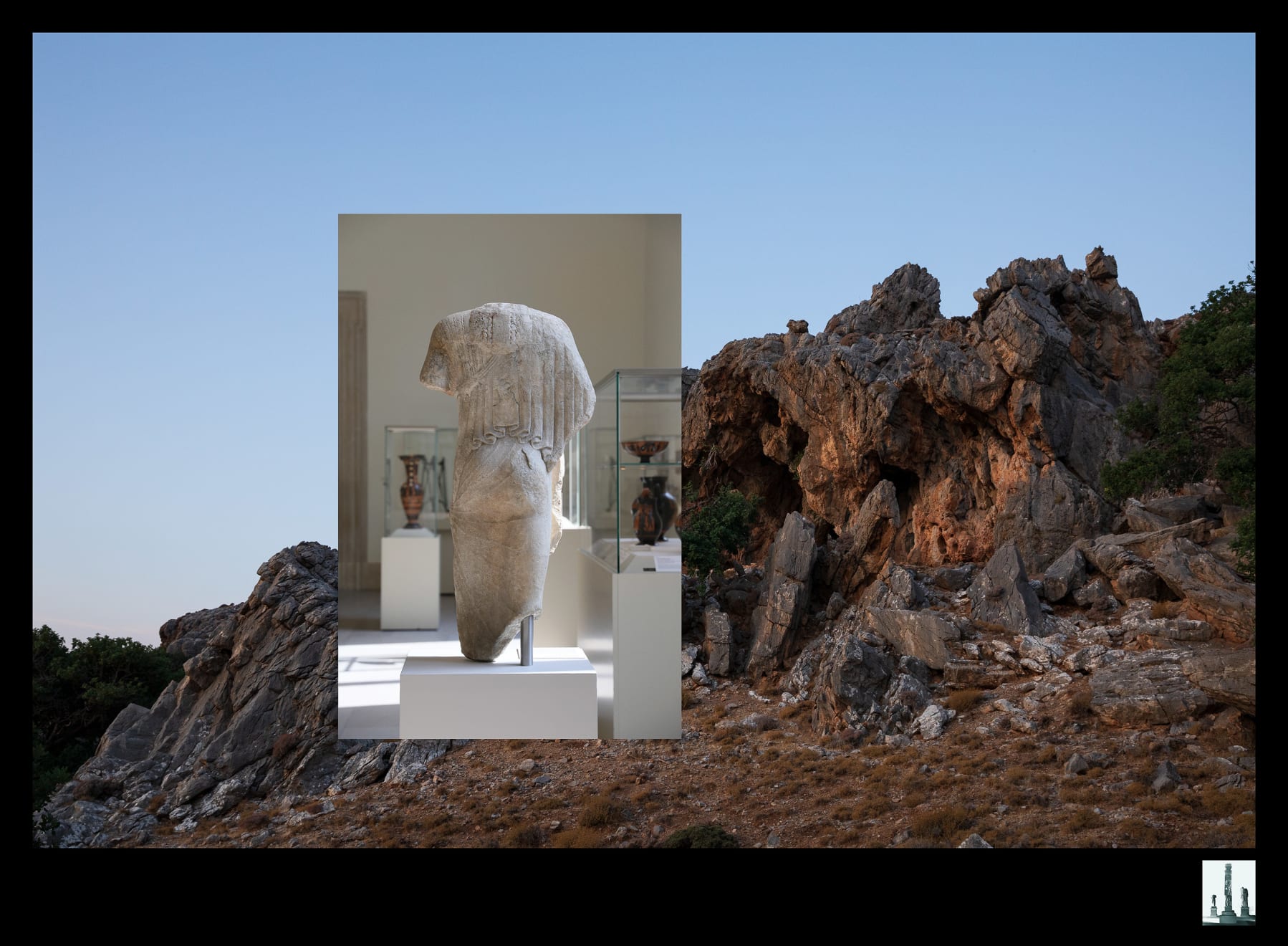Andrew Hazewinkel
Journeys in the Lifeworld of Stones (Displacement II) JM 237 / Met 07.306, 2010–2020
Digital chromogenic print, Diasec acrylic facemounted
116 x 158 cm
Edition of 3 plus 1 artist's proof
AH-000032
Colours, like stones, journey though the Lifeworld, setting out as minerals or pigments. In archaic times Black Sea Cinnibar provided bright reds, Orpiment from Ephesos golden yellows, Lazurite from Afghanistan...
Colours, like stones, journey though the Lifeworld, setting out as minerals or pigments. In archaic times Black Sea Cinnibar provided bright reds, Orpiment from Ephesos golden yellows, Lazurite from Afghanistan deep blues, and Chrysocolla, from Attica, a forest of greens. Colour in the ancient world, more than today, sent the beholder on imagined journeys. Like the songlines of indigenous Australia, colour-paths may have acted as wayfinders.
Research proves that archaic and classical sculpture was brightly painted, debunking the idea upheld by white supremacists, that their ideologies are legitimised by a lineage to the whiteness of the (supposedly) idealised bodies of classical antiquity. That research is caught up with the important work of decolonising museums. This body of photographic work doesn’t tackle those issues head on, rather it approaches them obliquely, focusing on the intimate consequences of a museologically stimulated collective amnesia toward cultural plunder. It resonates with a quote of I.Fokianaki from “How I Lost My Marbles; or, Calling for Colonial Patricide” (current online ed. Frieze) “A colonial logic persists in this relationship between the thief and the owner: the purloiner holds power.”
In the margin of this photograph is a digitised dry plate negative (c.1905) from an archive in Rome comprised of images created specifically for selling cultural artefacts to museums. Here the subject is a 6th c. BCE marble representation of a young woman. Elegantly attired in a style originating in the Greek coastal cities of Asia Minor, this young woman pulls her linen tunic tightly across her legs, her cropped cloak cascades in layered folds to her waist. I photographed her as if I were following her through the galleries at the Met (NYC) in 2017. The cave like formations of the contextualising landscape suggests shelter and earthy activity, perhaps a search for minerals, to be made into pigments to personalise everyday objects. This young woman stands with the force of forward movement, she knows where she is headed, much more clearly than we.
Research proves that archaic and classical sculpture was brightly painted, debunking the idea upheld by white supremacists, that their ideologies are legitimised by a lineage to the whiteness of the (supposedly) idealised bodies of classical antiquity. That research is caught up with the important work of decolonising museums. This body of photographic work doesn’t tackle those issues head on, rather it approaches them obliquely, focusing on the intimate consequences of a museologically stimulated collective amnesia toward cultural plunder. It resonates with a quote of I.Fokianaki from “How I Lost My Marbles; or, Calling for Colonial Patricide” (current online ed. Frieze) “A colonial logic persists in this relationship between the thief and the owner: the purloiner holds power.”
In the margin of this photograph is a digitised dry plate negative (c.1905) from an archive in Rome comprised of images created specifically for selling cultural artefacts to museums. Here the subject is a 6th c. BCE marble representation of a young woman. Elegantly attired in a style originating in the Greek coastal cities of Asia Minor, this young woman pulls her linen tunic tightly across her legs, her cropped cloak cascades in layered folds to her waist. I photographed her as if I were following her through the galleries at the Met (NYC) in 2017. The cave like formations of the contextualising landscape suggests shelter and earthy activity, perhaps a search for minerals, to be made into pigments to personalise everyday objects. This young woman stands with the force of forward movement, she knows where she is headed, much more clearly than we.
2
di
10


